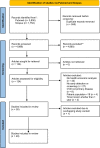Health Economic Research Assessing the Value of Early Detection of Cardiovascular Disease: A Systematic Review
- PMID: 37328633
- PMCID: PMC10492754
- DOI: 10.1007/s40273-023-01287-2
Health Economic Research Assessing the Value of Early Detection of Cardiovascular Disease: A Systematic Review
Abstract
Introduction: Cardiovascular disease (CVD) is the most prominent cause of death worldwide and has a major impact on healthcare budgets. While early detection strategies may reduce the overall CVD burden through earlier treatment, it is unclear which strategies are (most) efficient.
Aim: This systematic review reports on the cost effectiveness of recent early detection strategies for CVD in adult populations at risk.
Methods: PubMed and Scopus were searched to identify scientific articles published between January 2016 and May 2022. The first reviewer screened all articles, a second reviewer independently assessed a random 10% sample of the articles for validation. Discrepancies were solved through discussion, involving a third reviewer if necessary. All costs were converted to 2021 euros. Reporting quality of all studies was assessed using the CHEERS 2022 checklist.
Results: In total, 49 out of 5552 articles were included for data extraction and assessment of reporting quality, reporting on 48 unique early detection strategies. Early detection of atrial fibrillation in asymptomatic patients was most frequently studied (n = 15) followed by abdominal aortic aneurysm (n = 8), hypertension (n = 7) and predicted 10-year CVD risk (n = 5). Overall, 43 strategies (87.8%) were reported as cost effective and 11 (22.5%) CVD-related strategies reported cost reductions. Reporting quality ranged between 25 and 86%.
Conclusions: Current evidence suggests that early CVD detection strategies are predominantly cost effective and may reduce CVD-related costs compared with no early detection. However, the lack of standardisation complicates the comparison of cost-effectiveness outcomes between studies. Real-world cost effectiveness of early CVD detection strategies will depend on the target country and local context.
Registration of systematic review: CRD42022321585 in International Prospective Registry of Ongoing Systematic Reviews (PROSPERO) submitted at 10 May 2022.
© 2023. The Author(s).
Conflict of interest statement
The authors have no competing interests to declare.
Figures




References
-
- World Health Organisation. Cardiovascular diseases. 2017. https://www.who.int/health-topics/cardiovascular-diseases/. Accessed 24 Mar 2020.
-
- Institute for Health Metrics and Evaluation. GBD Results Tool | GHDx. http://ghdx.healthdata.org/gbd-results-tool. Accessed 1 May 2020.
-
- World Health Organization. Global spending on health: a world in transition. 2019.
-
- Wilkins E, et al. European Cardiovascular Disease Statistics 2017, Brussels. 2017.
Publication types
MeSH terms
LinkOut - more resources
Full Text Sources
Research Materials

